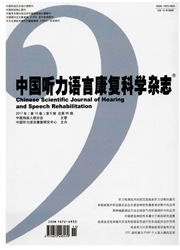

 中文摘要:
中文摘要:
目的通过一典型的有再生育要求的耳聋家庭病例,具体阐述耳聋产前诊断为耳聋家庭提供科学生育指导的内容、过程及意义。方法此耳聋家庭育有一子,为先天性耳聋患者,父母均为昕力正常者。对先证者进行详细的体格检查、昕力学及影像学检查后,采集先证者及其父母的外周血并提取DNA,进行GJB2,SLC26A4(PDS)基因分析和线粒体DNA(mtDNA)A1555G位点突变检测。明确受检者基因型并向该家庭提供遗传学信息后,在母亲妊娠早期(约10周)行产前诊断取材并提取DNA,明确胎儿的基因型。结果先证者携带GJB2复合突变,父母为携带者,此耳聋家庭再发风险为25%,产前诊断显示胎儿仅携带一个母系突变,出生后随访听力正常。结论耳聋产前诊断可为遗传性耳聋家庭提供科学的生育指导。
 英文摘要:
英文摘要:
Objective To evaluate the content, procedures and significance of prenatal care and guidance for the families of hereditary deafness. Methods The deaf family is composed of a deaf child and the parents with normal hearing. The proband underwent the physical examination, auditory testing, CT scan of the temporal bone and the genetic testing of GJB2, SLC26A4 and mitochondrial DNA (mtDNA) A1555G mutation. DNA was extracted from the peripheral blood of the parents. The family was counseled regarding the genetic information and the prenatal diagnosis was carried out in the fetus whose DNA was extracted from the fetus materials at about 10 weeks of gestation. Results The proband was proven to carry compound GJB2 mutations while the parents carried a single GJB2 mutation. The recurrence risk of their offspring was 25%. Prenatal diagnosis showed that the fetus only carried the maternal mutation. The newborn baby had normal hearing confirmed by a hearing screening. Conclusion Prenatal diagnosis accompanied with genetic testing can provide scientific genetic instructions.
 同期刊论文项目
同期刊论文项目
 同项目期刊论文
同项目期刊论文
 Extremely low penetrance of deafness associated with the mitochondrial 12S rRNA mutation in 16 Chine
Extremely low penetrance of deafness associated with the mitochondrial 12S rRNA mutation in 16 Chine Extremely low penetrance of deafness associated with the mitochondrial 12S rRNA T1095C mutation in t
Extremely low penetrance of deafness associated with the mitochondrial 12S rRNA T1095C mutation in t The mitochondrial tRNAAla T5628C variant may have a modifying role in the phenotypic manifestation o
The mitochondrial tRNAAla T5628C variant may have a modifying role in the phenotypic manifestation o Molecular Etiology of Hearing Impairment in Inner Mongolia: mutations in SLC26A4 gene and relevant p
Molecular Etiology of Hearing Impairment in Inner Mongolia: mutations in SLC26A4 gene and relevant p Construction of a multiplex allele-specific PCR-based universal array (ASPUA) and its application to
Construction of a multiplex allele-specific PCR-based universal array (ASPUA) and its application to 期刊信息
期刊信息
